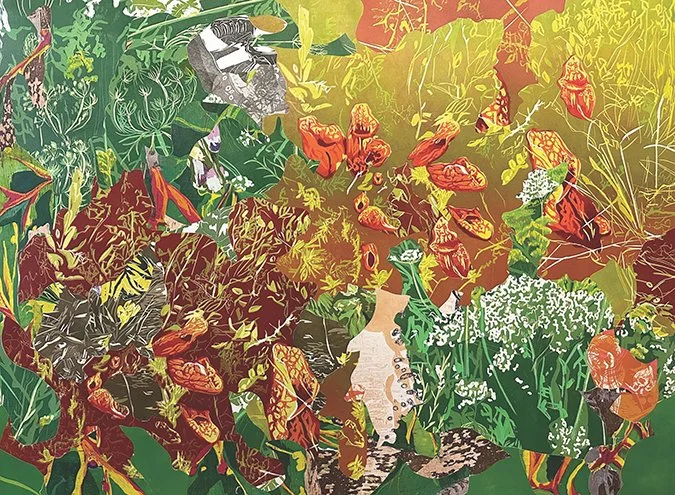
‘Biological narratives’
Untitled work (woodcut and lithograph collage) by Maine-based artist Amanda Lilleston in her show “Deep Field,’’ at The Zillman Art Museum, Bangor, Maine, through Dec. 30.
The museum says:
“Amanda Lilleston explores biological narratives through woodcut printing and collage in her exhibition deep field. The prints highlight the concept of transformation, depicted in burgeoning colors of flora. Lilleston began this body of work about ten years ago – the idea stemming from, ‘a broader, general interconnectedness of systems: biological, physiological, and ecological.’
“The themes that permeate her artwork reflect Lilleston’s educational and life experience – as well as motherhood. The artist explains that she has become ‘acutely aware of my body being part of a larger environment.’ Lilleston thoughtfully examines these natural subjects to allow for adaptation and change within the imagery.”
Turn of the 20th Century postcard. Bangor was for years one of the world’s lumber capitals because of its proximity to the Great North Woods and that Bangor was the last deep water port on the Penobscot River. It also had good freight and passenger rail service.
1918 logo
Jolly pandemic camping tent?
“The Force of Friendship ‘‘ (watercolor on paper), by Marcie Jan Bronstein, in her show “Being There,’’ at the University of Maine’s Zillman Art Museum, in Bangor.
The museum says that Ms. Bronstein uses :a wide variety of marks in her works, from shapes reminiscent of architecture to webs, stretched ovals and pill-like capsules. These varied forms, combined with the blooms of watercolor, make artworks begging for interpretation and ripe for reflection.’’
Statue of the mythical Paul Bunyan in Bangor, where the lumber industry was economic king for many years, starting in the 19th Century but no more. Since Bangor lies on the Penobscot River, logs from Maine’s immense North Woods could be floated downstream to the city and processed at its water-powered sawmills, and then shipped to the Atlantic Ocean, 30 miles farther downstream, and from there to any port in the world. Many of the lumber barons’ elaborate Greek Revival and Victorian mansions suggest the wealth made in this business.




